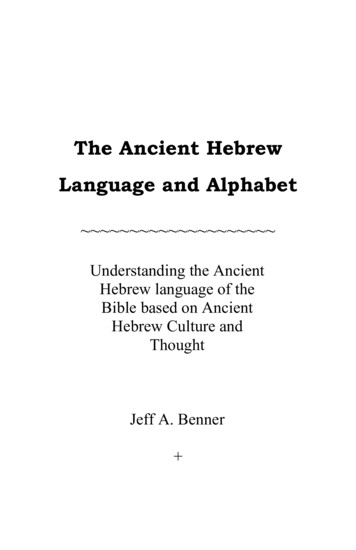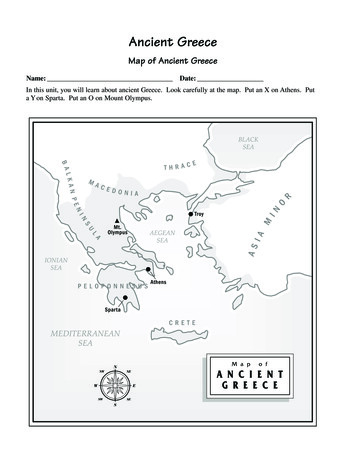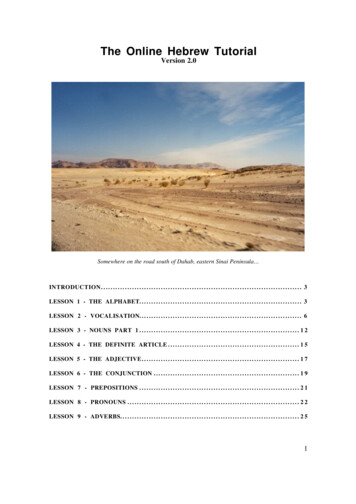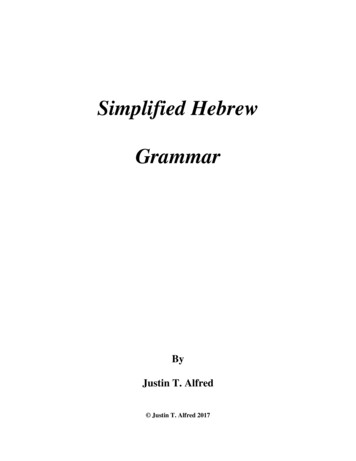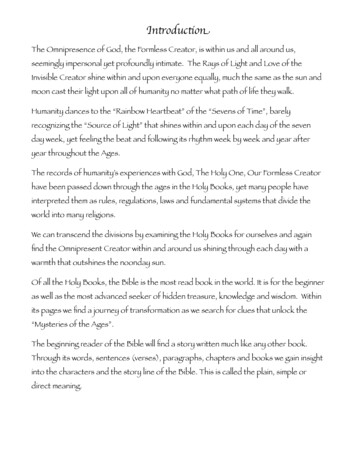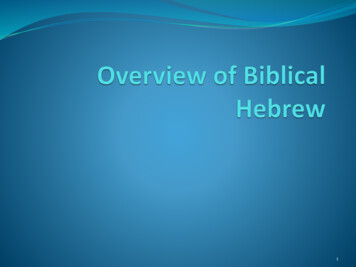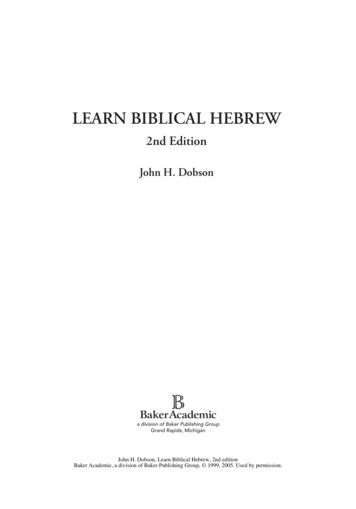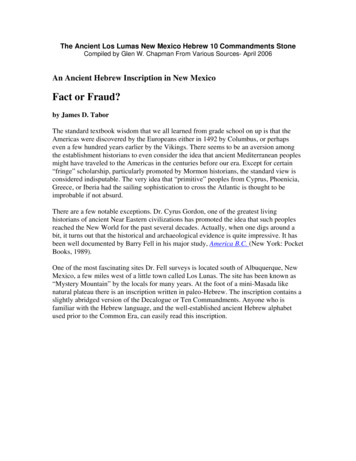
Transcription
The Ancient Los Lumas New Mexico Hebrew 10 Commandments StoneCompiled by Glen W. Chapman From Various Sources- April 2006An Ancient Hebrew Inscription in New MexicoFact or Fraud?by James D. TaborThe standard textbook wisdom that we all learned from grade school on up is that theAmericas were discovered by the Europeans either in 1492 by Columbus, or perhapseven a few hundred years earlier by the Vikings. There seems to be an aversion amongthe establishment historians to even consider the idea that ancient Mediterranean peoplesmight have traveled to the Americas in the centuries before our era. Except for certain“fringe” scholarship, particularly promoted by Mormon historians, the standard view isconsidered indisputable. The very idea that “primitive” peoples from Cyprus, Phoenicia,Greece, or Iberia had the sailing sophistication to cross the Atlantic is thought to beimprobable if not absurd.There are a few notable exceptions. Dr. Cyrus Gordon, one of the greatest livinghistorians of ancient Near Eastern civilizations has promoted the idea that such peoplesreached the New World for the past several decades. Actually, when one digs around abit, it turns out that the historical and archaeological evidence is quite impressive. It hasbeen well documented by Barry Fell in his major study, America B.C. (New York: PocketBooks, 1989).One of the most fascinating sites Dr. Fell surveys is located south of Albuquerque, NewMexico, a few miles west of a little town called Los Lunas. The site has been known as“Mystery Mountain” by the locals for many years. At the foot of a mini-Masada likenatural plateau there is an inscription written in paleo-Hebrew. The inscription contains aslightly abridged version of the Decalogue or Ten Commandments. Anyone who isfamiliar with the Hebrew language, and the well-established ancient Hebrew alphabetused prior to the Common Era, can easily read this inscription.
The question is—how did it get there? Isit a fraud, perpetrated by some prankstersfor amusement purposes? If so, it couldnot be much older than this century sincethe paleo-Hebrew alphabet was onlydiscovered from archaeologicalinscriptions in the Middle East over thepast 100 years. Or, is it possible that itwas put there much earlier, by Jews orIsraelites who had settled in the area weknow as New Mexico when paleoHebrew was in common use—that is inthe centuries B.C.E. To even suggestClick Image for Larger Viewsuch an idea, for most, is to immediatelydismiss it. However, when the Los Lunasinscription is placed in the wider context of an abundant amount of evidence, such as thatpresented by Dr. Fell, that ancient Mediterranean peoples did visit the New World, itbecomes not only plausible but perhaps the only logical explanation for the existence ofthis text.In September, 1996 I visited the Los Lunas site with a group of associates for an initialsurvey of the evidence. I have also interviewed Prof. Frank Hibben, local historian andarchaeologist from the University of New Mexico, who is convinced the inscription isancient and thus authentic. He reports that he first saw the text in 1933. At the time it wascovered with lichen and patination and was hardly visible. He was taken to the site by aguide who had seen it as a boy, back in the 1880s. Thus we have eye-witness evidence,going back over a hundred years, that the inscription existed. This alone is impressive,since it is rather preposterous to imagine some pranksters or forgers operating with aknowledge of paleo-Hebrew in the late 1800s, when this ancient alphabet was not evenfully known to the scholars.Associated with the inscription is the mountain itself, which shows evidence offortification and ancient habitation, whether by native Americans or whomever. TheDecalogue inscription is located at the foot of the mountain, on the north, at the onlyaccessible pathway going up. The top of the mountain is a flat plateau with many ruins.The whole area is covered with drawings on rocks called petroglyphs. One of the mostinteresting of these petroglyphs is what appears to be a sky-map, laid out on a flat rock,recording the positions of the planets and constellations during a solar eclipse. ResearcherDavid Deal, to whom we owe credit for a drawing of the site, has identified the eclipseastronomically as occurring on September 15, 107 B. C. E. I have run that date on asophisticated computer calendar that does conversions to the ancient Hebrew calendarand surprisingly, that date turns out to fall on Tishri 1st, or Rosh HaShanah of that year—107 B.C.E.! Mr. Deal, who first did the astronomical calculations, was not even aware ofthis correlation. It might well be the case that the ancient Israelites who lived on thismountain, and left their inscription of the Ten Commandments at the “Gate” of the camp,
also recorded an eclipse that happened to fall on a very important day in their sacredcalendar.I have become tentatively convinced that the Los Lunas inscription offers solid evidencethat ancient Israelites explored and settled in the New World in the centuries before theCommon Era. Whether we can precisely date this encampment, based on Mr. Deal’sastronomical evidence, remains in discussion. However, I have little doubt, nor does Dr.Gordon, who is one of the world experts on ancient inscriptions, that the text itself isauthentic and was written sometime B.C.E. Beyond this we can not go at this point intime. What is needed is a rigorous archaeological examination of the whole mountain andits human artifacts. It was obvious to us, even from our brief survey last Fall, that the sitehas been inhabited by successive peoples. We would have to have coin and potteryevidence to more precisely identify these remains and correlate them, if possible, with theinscription itself. The author is in the process of investigating possibilities for just such aninvestigation, led by qualified experts in archaeology. In the meantime I would encourageany of our Bulletin readers who are interested in this subject to read Dr. Barry Fell’sbook, America B.C., which is readily available in major bookstores.A FAR-WANDERING LOST TRIBE?Imagine hiking near Los Lunas, New Mexico, and coming upon a huge basaltboulder inscribed as shown in the illustration.This is obviously not an Indian petroglyph. Rather, it is the Ten Commandmentsset down in an old Hebrew script. The script and its translation seemunmysterious. What everyone wants to know is: Who chiseled it and when? Itwas apparently discovered in the 1880s. Harvard anthropologist Frank C. Hibbenvisited the site in 1930 and pronounced the inscription to be at least 100 yearsold. Who in New Mexico in 1830 knew ancient Hebrew? The inscription may bemuch older, for the whole boulder, weighing 60-80 tons, is tipped 20-30 ,probably by geological forces, so that the lines of script are tilted.
(Underwood, L. Lyle; "The Los Lunas Inscription," Epigraphic Society,Occasional Publications, vol. 10, no. 237, 1982.)Commandment Stone right here in Los Lunas?Below you'll read the most interesting information. I've copied most of the article from the following site but if you use the linkthen you'll also find PICTURES: ica's ancient Indian's called it the "Cliff of the Strange Writings". It has been named Phoenician Rock or the CommandmentStone. It is called today Inscription rock. Located west of Los Lunas, New Mexico at the base of Mystery Mountain (also calledHidden Mountain) this rock has been raising some eyebrows.The strange chiseled characters on the volcanic basalt rock were undecipherable by America's early European settlers and to the"native" Indians. (Hence, the mountain's name - Mystery). The local residents had been made aware, by the Indians, of theunusual inscription as early as the year 1800. Why is this rock causing such excitement?The stone preserves an abbreviated form of the Ten Commandments as written in Exodus 20, which is very exciting, butwhat makes this stone an enigma is the fact that the writing is clearly semitic in origin. The ancient Hebrew inscriptions wereonce thought to be a combination of Greek, Hebrew and Phoenician characters but now are clearly seen as a form of Hebrewwriting dating to approximately 1000 B.C.! The Greeks "borrowed" from the Phonetic alphabet so the characters would befamiliar. The Hebrews and the Phoenicians were neighbors which, in their trading environment, shared the same language andalphabet. The style of the characters is strikingly similar, almost identical, to that used on the Moabite Stone in the days of theIsraelite kings Omri and Ahab. The Moab stone was engraved by captive Israelites for the Moabite king, Mescha, as per its owninscription. After examining the Los lunas site geologist, George Morehouse, estimated the placement of this Decalogueinscription up to 3000 years ago, which would, again, date it around 1000 B.C. Just how were historians to explain how aseventy ton boulder with Hebrew inscription appeared on this mountain landscape in North America around 1000 B.C.?Over two thousand years before Columbus "discovered" America there were people of semitic origin in New Mexicoworshipping the God of Israel. How can this possibly be reconciled with known history? It is seemingly apparent that thefinancial backing to launch a Hebrew-Phoenician voyage of world exploration could have readily occurred during the reign ofKing Solomon of Israel. Solomon worshipped the true God of Israel and had the means to fund explorative voyages to otherlands. With Solomon's main port being located on the Red Sea it would be difficult to explain how his fleet would have enteredAmerica through the Atlantic drainage.( Reference note:1Kings 9:26 And king Solomon made a navy of ships in Eziongeber, which is beside Eloth, on the shore of theRed sea, in the land of Edom.27 And Hiram sent in the navy his servants, shipmen that had knowledge of the sea, with theservants of Solomon.)Tarshish , however, had access to the Atlantic. The reign of Solomon was enveloping the entire world. Israel's close neighbor,Phonecia, and their expert navigators were working with the servants of Solomon from both countries ports. The ships ofTarshish sailed extremely long voyages to bring back all kinds of raw materials and items (copper & other ores, flora & faunasamples, "exotic" animals, etc.).( Reference note:2Ch 9:21 For the king's ships went to Tarshish with the servants of Huram: every three years once came theships of Tarshish bringing gold, and silver, ivory, and apes, and peacocks.)It would help explain the need of three year journeys if the seamen had to cross the ocean to come to these far off isles inAmerica. The fact that the trading ships of Phoenicia did have docks in ancient America can be proved from inscriptions they leftbehind. ( See Dr. Barry Fell's book America B.C. and also reading Steven M. Collins The "Lost" Ten Tribes of Israel.Found! ishighly recommended) The Los Lunas site is located along the Puerco River which is tributary of the Rio Grande River. The RioGrande is definitely in the Atlantic drainage. It would have been entirely possible for the Hebrew-Phonecian sailors to access thearea of the stone.We must realize that our history was written by the Greeks (and Romans) and is told entirely from their self-glorifying viewpointwhich sometimes tends to omit other nations contributions to the world. Columbus didn't discover America. How is it that therewere people (some of semitic features) already living in America for centuries before Columbus? Ancient colonists andprospectors? Why is it that some of the words and alphabet characters of these ancients also resemble Hebrew or Ibunic-
Phoenician? How is it that some of the same pagan gods and symbols were worshipped on both ends of the earth simultaneously?And is there any other explanation why the commandments of the God of Israel would be written in the middle of the NorthAmerican continent in Hebrew characters?The inscription has been translated by the Epigraphic Society as follows:I (am) Jehovah [the Eternal] Eloah [your God] who brought you out of the land of Mitsrayim [Mizraim or the two Egypts] outof the house of bondages. You shall not have other [foreign] gods in place of (me). You shall not make foryourself molded (or carved) idols [graven images]. You shall not lift up your voice to connect the name ofJehovah in hate. Remember you (the) Sabbath to make it holy. Honor your father and your mother to makelong your existence upon the land which Jehovah Eloah [the Eternal your God] gave to you. You shall notmurder. You shall not commit adultery (or idolatry). You shall not steal (or deceive). You shall not bearwitness against your neighbor, testimony for a bribe. You shall not covet (the) wife of your neighborand all which belongs to your neighbor.The Los Lunas Commandment Stone is one of several proofs that exist in America that the ancients of Israel, including both theworshippers of the false gods such as Baal and of the True Eternal God, walked on this continent long before Columbus or any ofthe 14th century European explorers. It is also another proof that biblical history is accurate. In the past, when a "new" worldkingdom came into power they had the option of re-writing how their history and the history of those in subjection to them wouldbe remembered. It was not uncommon to strike out the good things acheived by a former power that was now in subjection orexile. Or even to ascribe the glory of the former powers conquests to themselves. The bible, and the history of Israel that itcontains, is refreshingly honest in its history of battles won and lost. It does not cover up Israel's mistakes or captivities. God'sword is truth. History's word is questionable. It is obvious that the writers of world history knew of these ancient travellers butneglected to tell the story of history from a neutral standpoint. Reality to each of us is what we are taught. Truth is what isabsolute, beyond the perception of men and their "reality". History has some explaining to do.Hebrew Artifacts in AmericaThere are numerous other artifacts withHebrew on them from these states:Illinois, Iowa, Indiana, Ohio, Michigan, Pennsylvania,West Virginia, Virginia, New York, Massachusetts,Kentucky, Tennessee, New Mexico, Colorado, Utah,California, and probably others in the contiguous 48states, it would not be surprising to us. I am stillamazed that there are some people out there that stillfalsely believe that North American natives had nowritten language prior to the arrival of the Europeansin Columbus' time. Two native writing systems (andpossibly two more) are known to have survived intohistoric times: Micmac and Cherokee. The other twoare possibly Blackfoot and Hopi. The Hopi (I've heardthey won't discuss it) is rumored to be Hebrew. Theremay have been other written languages as well.Indian Petroglyphs at the Los Lunas siteThe Decalogue inscription is located at the foot of the Hidden Mountains onthe north-eastern side, at the only acessible pathway going up. However, thereare other artefacts of interest, too. When James D. Tabor did his survey of thewhole site in 1996 he reported the existence of some leftovers of an ancient
habitation (see 8). If there was an ancient fortification, as he claims there was, itcertainly is not immediately visible from the ground to the untrained eye.However, the whole site, especially the top and the north-eastern rocksand slopes, are covered with petroglyphs.The researcher David Deal has published a detailed analysis for one of thesepetroglyphs (3) . It depicts a sky-map, laid out on a flat rock, recording thepositions of the planets and constellations during a solar eclipse. It coincides withthe solar eclipse on September 15, 107 B.C.E., to be followed by the Jewish"Rosh Ha Shannah" on the next day. This interesting discovery was firstpublished by David Deal back in 1984. "Rosh Ha Shanah" is the first day of theJewish month of "Tishri". "Ethanim" was the old-Hebrew name for "Tishri"refering to the seventh lunar month of the sacred calendar of the Israelites. It wasalso regarded as the first month of their secular calendar, especially in anagricultural sense. Like David Deal, James D. Tabor, too, emphasizes thesignificance between the date of the Los Lunas solar eclipse on September 15107 B.C.E. and the Jewish New Year. However, he thinks both events were onthe same day (8).Another interesting petroglyph, whose picture is shown below here for the firsttime on the Web, seems to portrait an ancient high-ranking mediterranean visitor,possibly wearing a crown. Crowns were unknown to native American Indians.They are of Middle Eastern or Mediterranean origin. The small cross-like symbolin the circle below looks like an artistic representation of the old-Hebrew orPhoenician letter TETH. This might be just a coincidence, but should be takeninto consideration in view of the other Hebrew or Phoenician artifacts on thatsame site.
Left: An unidentified petroglyph depicting aface and with what looks like a crown on itshead. It is less than 50 yards away from theDecalogue inscription. Does the circle withthe cross below the face represent an oldHebrew or Phoenician TETH character?See drawing below.Photo: J.Neuhoff 1996The Los Lunas Inscription of New MexicoClick image for larger pictureThe above inscription is very unique for several reasons. First, it is written in an ancientHebrew script. Second it is located near the small town of Los Lunas in the State of NewMexico, USA. Third, the inscription is of the "Ten Commandments".Is this inscription an original or a fake. If it is original, this proves that a Semitic people,
probably Hebrews, arrived in the Americas long before Columbus or the Vikings.The above inscription cannot be a fake for the following reasons. The actual time ofdiscovery of the inscription is not known but was known by the locals as far back as the1850's. At that time, the script of the text was unknown and therefore undecipherable. It wasnot until this last century that the ancient Hebrew (paleo-Hebrew) script was discovered inthe Near East. Once this ancient script was discovered the Los Lunas inscription could bedeciphered and was found to be a copy of the "Ten Commandments".Click image for larger pictureWhen we compare the script on the Los Lunas inscription with the above inscription foundin 1993 at Tell Dan in the land of Israel, we find that the scripts are almost identical. Belowis a comparison of the scripts from both inscriptions.
The Tel Dan inscription was written around 1000 BCE. Since the Los Lunas inscription usesthe same script, it is safe to conclude that the Los Lunas inscription was written by aHebrew people about 3,000 years ago. Other ancient Hebrew inscriptions have been foundaround the country including Tenessee and the Mississippi Valley. The "ArcheologicalOutliers Homepage" includes other ancient Hebrew artifacts found in the United States. Thearticle "Who Really Discovered America?" also includes some very interesting informationon the Los Lunas inscriptions as well as other finds and includes a possible link between theGold of Solomon and the Gold of Brazil.Copyright 2006Ancient Hebrew Research CenterTurning Right at the ‘Burning Bush:’ Reflections on a NationalTreasure from Ancient AmericaByRoger L. Williamson B.A; M. Div.
IntroductionAfter retiring from a career in the military, I now teach in public school and teach an Old Testament survey courseat the local college. Even though it may be a survey course in Old Testament, one cannot avoid the Hebrewlanguage. While researching paleo-Hebrew I ran into an inscription written in this ancient language. An abridgedversion of the 10 Commandments, this inscription resided in a desert. Nothing would raise an eyebrow if thisinscription were to be discovered in the Sinai somewhere; but the fact that this inscription is found in New Mexico,US of A?That was two years ago. The degree of my amazement has never faded. The Los Lunas Decalogue is addictive. Thestone sticks with you and sticks it to you with more questions than answers. Like some headmaster with a big ruler;this stone challenges old assumptions; requires a mastery of language, research of both Old and New World times.Consistent is the fact that few are aware of the stone inscription; even the locals. About 10 miles out in the desert Idid ask for directions from a lady in a trailer office of a rock crushing company. Trucks loaded with gravel wouldpull up to this officer trailer and she would record the tonnage or something like that.“Excuse me, I am looking for directions. I am looking for a mesa nearby called Mystery Mountain. Would youhappen to know where this is located?”“No, never heard of it,” she said.“Well, it is also called the Los Lunas Decalogue Stone.”
“What’s a “Decalogue?”“Oh, Decalogue is a word that refers to the 10 Commandments. Do you know of a mesa/mountain that has a stonewith the 10 Commandments on it?“Never heard of it,” she replied, “but I saw people bumping around the desert six month ago. Saw the silly peopleruining their truck from that window. We have some crazy people visit this area.”For the most part, people genuinely want to give you what you are asking for; especially directions and there is afrustration when they cannot.“Honey,” [I love it when people call you honey] “I don’t know where this mountain you are speaking of is, but youprobably have not gone far enough. Keep going and turn right at the burning bush.”We both fell out laughing and I thanked her. Even the locals are unaware of this awesome stone written in a veryold language.She was right about one thing. I had not gone far enough. With several more hours I put the satellite photo intofocus of the Rio Puerco ; railroad tracks and a bridge across. There was only one badly sun faded sign that said:“Mystery Mountain.” I was at the right mesa. Two more hours of wandering around dead end drops I saw the twinpeaks and honed in on it. Once I could see the avenue of approach, the first sight of the stone was no more than a1000 meters forward.
Observations on Physical Features of the StoneThe Los Lunas Mesa has the finest silted sand at its base I can remember. Walking on a very fine sand dune wouldbe a fair equivalent. This finely ground sand will play a part of nature’s relationship to this stone inscription.The Decalogue Stone makes a great first impression. You climb a very small trail for a while and over the first rise,the stone becomes visible. It is big and impressive. The majority of pictures are close up pictures that do not showthe relationship with the rest of the rock. Additionally, wonderful scholarship has been done on the script andtranslation of the stone, but not pausing to consider where it sits, why it sits that way; and the nature of basalt rockitself.1. Assumption #1: Facing the stone; it is sinking downward to the right.2. Assumption #2: At the time of the inscription the stone was more or less on a 45 degree levelplane.There is no sliding or rolling with the big stone where the inscription is carved. The ravine it sits in must be anawesome display of water and “sandpaper” silt during the rainy seasons. This water erosion has literally taken thefloor out from under the bolder. It is an amazement to me there is the complete inscription still remaining.From top to bottom, there are nine lines of inscription. From line four downward the surface has been sandpaperedsmooth. It would not be inconceivable to have the stone complete submerged with rushing water up to the fourth;possibly third line. The very top of the inscription surface bares a more uneven surface and indicates this surfacerelief is more related to the time of origin.Would that we could measure natures rate of erosion or how long it would take for a surface at the top of the stoneto be “sanded” to the surface that is from line four down.It does indicate a long time.The top edges of the inscription are jagged and have very important markings for observation. The bottom is theexact opposite. Its jagged edges are rounded and smooth. These are again “before” and “after” shots. We are notable to accurately date the stone, but initial observation sure indicates antiquity.Before considering Assumption #2 further, I want to make a few observations as to the degree of sinking/settling.The script characters are as close to perpendicular (90 deg) from the stone orientation as one could possibly make it.I think it is a fair assumption due to the entire orientation of the inscription. Whoever the author is; just observingthe script construction, points to a very block and spatial awareness. With the exception of line two (a mistake I willdeal with later), each letter is: 1) Very close to even sizing and 2) Even spacing both between letter and sentences.It is more probable, this inscriber made these letters when the stone was level to him and waist to low chest high.Assumption #2 is supported by another feature; the markings on the top edge. This stone surface had to be preparedbefore any script. If you observe close up the very top left hand edge of the stone you will see what I believe to bethe chisel mark. When struck sharply great flakes of stone will shear off on to the floor; leaving a clean surface.
That mark may indicate the size of his chisel.On the left hand side corner you can see the probable depth of the break off. The indentation is about a thumb’slength deep. These marking points of impact are all along the top edge. Like the block and perpendicular script;these preparation points of impact are relatively in line with the stone. This is yet another supporting observationthat the stone was more level when it was originally prepared.Again, would that we could measure the rate of settling with this bolder holding the great inscription. If geologistscan measure the rate of movement in the San Andreas Fault, surely, something could be done to measure the rate ofnature’s working on this bolder. Based on physical evidence, it would be a closer approximation of age than hasbeen reached so far.The erosion “sanding” process, the letter orientation of the scrip, the preparation marking that cleared the surface forinscription set up for me a relationship between the markings and nature’s aging. Not only is this script old, but thephysical observation points in this direction too.
The Physical Construction of the ScriptWe have already observed the 90 degree orientation of the script as it relates to the stone. Whoever this chiselerwas, hecould not have used the same force in preparing the stone as in making the letters. I did not find these lettersto be very deep, but it seems to me:1. the implement used to make the letters was icepick pointed and not like the point of a screwdriver.2. He did not hammer; he tapped. In the entire construction of this man’s statement, he ran the risk ofshattering the surface of basalt. One mistake and the entire inscription would require re-surfacingor finding another stone.Someone suggested this was no scribe or priestly background because any “trained” person would have measuredhis sentence lines, and chalked out his letters. It is correct, he was no scribe or priestly class (i.e. Leviticalbackground), but not for the reasons put forth above. To the letter; word for word, this is a deliberate inscription;minus his great mistake. It was meticulously achieved in fine tapping.The Author was familiar with this kind of rock and how to work with it in order to achieve the results he did. Thereis a high degree of functional skill here.I know it is a stretch, but the ground in front of the stone is curiously level. Since this is the only level section in theentire approach I wonder if there was something in front of the inscription when the stone was somewhat level.The Script and Version of the 10 CommandmentsThe inscription reads from right to left placing the script within a certain family of languages; the Semitic Family.Minus the three or four letters that have broken off, and minus the period separation points and the caret, there are216 characters inscribed on the stone. All 22 letters of a Semitic/Phoenician/Paleo-Hebrew alephbet are employed.The execution of these characters are deliberate and measured: line 1 (28 characters); L2 (21); L3 (28); L4 (21); L5(28); L6 (29); L7 (25); L8 (25); and L9 (10). Even the smaller last two lines are symmetrically centered. It would bea fair assumption that he has done this before.David Deal has a wonderful depth to the language of Los Lunas in his book Discovery of Ancient America. Hewrites:“They (the letters) are clearly and unequivocally a form of paleo-Hebrew. A comparison of alphabetseasily proves this point. All but five of the letters found on Inscription Rock are immediatelyrecognized as common forms of paleo-Hebrew.” (page 3-4)David Deal not only penetrates the code of the scripts, but contributes a very accurate translation; and his interestpushes on into the conviction that Hebrew has given the “Ancient America(s)” one of its large linguistic taproots.Almost all linguistic translators of the Decalogue stone agree that Phoenician Script has a strong foundation. The
important point to learn here is that the letters used in Los Lunas are not homogeneous! The scripts on this stone tellof many scripts from many ports of call.Lets take it from the easiest to the more difficult. The letter Tet (T) is Greek Script. Iberic script; both northern andsouthern, display an X. Phoenician script displays the circle X; as does Aramaic and specifically the Estrangelascript is no match even close to Los Lunas.The letter Lamed (L) comes from a Greek port of call. It is heavily used and consistently vertical up and 90 degreesin 21 times. Lamed (L) is used as a prefix (to), and it is the first letter in the word no or not,
Apr 11, 2012 · The ancient Hebrew inscriptions were once thought to be a combination of Greek, Hebrew and Phoenician characters but now are clearly seen as a form of Hebrew writing dating to approximately 1000 B.C.! The Greeks "borrowed" from the Phonetic



